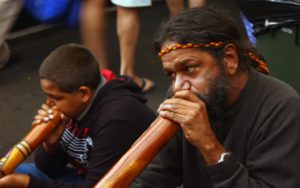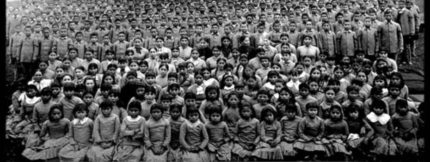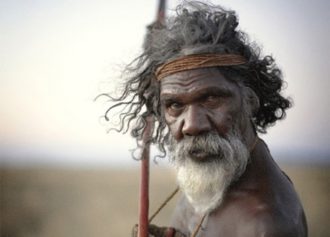
Aboriginal performers play didgeridoos at Fremantle Markets in 2009
Anthropologists have long suspected that modern day Australian Aborigines descend from one of the first waves of migrants out of Africa. The prehistoric humans reached the Pacific continent some 50,000 years ago and were left relatively isolated until the first Europeans arrived in the late 1700’s.
Outside of native Africans, Australian Aborigines are said to have the oldest living civilization in the world.
This genetic confinement makes their DNA particularly intriguing for scientists, and a recent study seems to confirm most literature on the subject.
Researchers from the Wellcome Trust Sanger Institute in the UK and La Trobe University in Melbourne partnered to complete the first comprehensive sequencing of the Aboriginal Australian Y chromosome, a molecule passed only from father to son, and found deep roots tracing back to that first settlement.
The scientists worked very closely with the local Aboriginal community for the years-long project, recruiting a respected elder to serve as liaison between the groups. Thirteen Aboriginal men contributed their DNA to the study.
John Mitchell, an associate professor at La Trobe University, expressed his gratitude to the populace in a statement released by the Institute.
“Clearly there is keen interest in the Aboriginal community to explore their genetic ancestry and without them this study would not be possible,” Mitchell said. “This collaboration in genome sequencing, to explore their ancient history, was made possible by years of engagement beforehand with Aboriginal communities.”
Mitchell and colleagues first presented their findings to the indigenous Australians before releasing the results to the rest of the world.
Lesley Williams, the study’s cultural advisor, said the study lined up with ancient Aboriginal folklore.
“As an Aboriginal Elder and cultural consultant for this project I am delighted, although not surprised, that science has confirmed what our ancestors have taught us over many generations, that we have lived here since the Dreaming.”
The Dreaming, sometimes called Dreamtime, is a significant element of Aboriginal spirituality and culture. It refers to the mythological era in which ancestral beings rose from the Earth to create the universe and all its inhabitants.
The British and Australian geneticists published their paper in the Current Biology journal in February.
The results challenged a previous genetic study, which theorized that Aborigines intermixed with peoples from the Indian subcontinent around 4,200 years ago. The 2013 study pointed to unique archeological finds that coincided with the proposed influx: the use of more refined stone tools and the introduction of the dingo. Though the wild canine is an iconic symbol of the Australian Outback, researchers know it is not native to the island. The oldest traces of the animal date back only a few thousand years, and it is a placental mammal that carries its young in the womb, whereas Australia’s indigenous mammals are all marsupials.
“The data show that Aboriginal Australian Y chromosomes are very distinct from Indian ones,” said Anders Bergstrom, lead author.
The new study found that the Aboriginal Y chromosomes diverged from those found in Indian and Sri Lankan male DNA around 54,000 years ago. The Aborigines share a more recent ancestor with the Papua New Guineans.
Archaeologists believe the two countries formed a single landmass until about 14,000 years ago when the earth’s temperature began to rise signaling the end of the Ice Age. Elevated sea levels submerged the bridge of land connecting them.
“These results refute the previous Y chromosome study, thus excluding this part of the puzzle as providing evidence for a prehistoric migration from India. Instead, the results are in agreement with the archaeological record about when people arrived in this part of the world,” Bergstrom added.
The paper however did not solve the mystery of the dingo.


